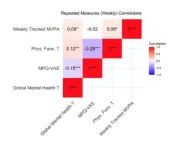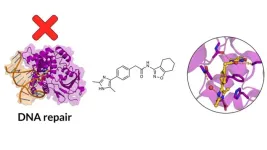(Press-News.org) While we are remarkably capable of generating our own goals, beginning with child’s play and continuing into adulthood, we don’t yet have computer models for understanding this human ability.
However, a team of New York University scientists has now created a computer model that can represent and generate human-like goals by learning from how people create games. The work, reported in the journal Nature Machine Intelligence, could lead to AI systems that better understand human intentions and more faithfully model and align with our goals. It may also lead to AI systems that can help us design more human-like games.
“While goals are fundamental to human behavior, we know very little about how people represent and come up with them—and lack models that capture the richness and creativity of human-generated goals,” explains Guy Davidson, the paper’s lead author and an NYU doctoral student. “Our research provides a new framework for understanding how people create and represent goals, which could help develop more creative, original, and effective AI systems.”
Despite considerable experimental and computational work on goals and goal-oriented behavior, AI models are still far from capturing the richness of everyday human goals. To address this gap, the paper’s authors studied how humans create their own goals, or tasks, in order to potentially illuminate how both are generated.
The researchers began by capturing how humans describe goal-setting actions through a series of online experiments.
They placed participants in a virtual room that contained several objects. The participants were asked to imagine and propose a wide range of playful goals, or games, linked to the room’s contents—e.g., bouncing a ball into a bin by first throwing it off a wall or stacking games involving building towers from wooden blocks. The researchers recorded the participants’ descriptions of these goals linked to the devised games—nearly 100 games in total. These descriptions formed a dataset of games from which the researchers’ model learned.
While human-goal generation may seem limitless, the goals study participants created were guided by a finite number of simple principles of both common sense (goals must be physically plausible) and recombination (new goals are created from shared gameplay elements). For instance, participants created rules in which a ball could realistically be thrown in a bin or bounced off a wall (plausibility) and combined basic throwing elements to create various games (off the wall, onto the bed, throwing from the desk, with or without knocking blocks over, etc., as examples of recombination).
The researchers then trained the AI model to create goal-oriented games using the rules and objectives developed by the human participants. To determine if these AI-created goals aligned with those created by humans, the researchers asked a new group of participants to rate games along several attributes, such as fun, creativity, and difficulty. Participants rated both human-generated and AI-produced games, as in the example below:
Human-created game:
Gameplay: throw a ball so that it touches a wall and then either catch it or touch it
Scoring: you get 1 point for each time you successfully throw the ball, it touches a wall, and you are either holding it again or touching it after its flight
AI-created game:
Gameplay: throw dodgeballs so that they land and come to rest on the top shelf; the game ends after 30 seconds
Scoring: you get 1 point for each dodgeball that is resting on the top shelf at the end of the game
Overall, the human participants gave similar ratings to human-created games and those generated by the AI model. These results indicate that the model successfully captured the ways humans develop new goals and generated its own playful goals that were indistinguishable from human-created ones.
This research helps further our understanding of how we form goals, and how these goals can be represented to computers. It can also help us create systems that aid in designing games and other playful activities.
The paper’s other authors are Graham Todd, an NYU doctoral student, Julian Togelius, an associate professor at NYU’s Tandon School of Engineering, Todd M. Gureckis, a professor in NYU’s Department of Psychology, and Brenden M. Lake, an associate professor in NYU’s Center for Data Science and Department of Psychology.
The research was supported by grants from the National Science Foundation (1922658, BCS 2121102).
END
AI generates playful, human-like games
Researchers develop computer model to understand and generate human-like goals
2025-02-26
ELSE PRESS RELEASES FROM THIS DATE:
Bacteria ‘leaking across stomach lining’ could indicate risk of gastric cancer, new study has found
2025-02-26
A pioneering study has revealed new insights into the role of gastric bacteria in stomach cancer development that could pave the way for a more effective treatment of pre-cancer according to a study published today in Helicobacter.
The Royal Society and Cancer Research UK-funded research led by Dr Amanda Rossiter-Pearson at the University of Birmingham identified a crucial interaction between Helicobacter pylori and non-H. pylori bacteria in the pre-cancerous stage of gastric cancer.
Gastric cancer is the fourth ...
Feeding anemone: Symbiote fish actively feed hosts in wild
2025-02-26
Anemonefish, sometimes called clownfish, have been popular attractions in aquariums ever since Disney’s animated film Finding Nemo arrived in cinemas in 2003. Living symbiotically with sea anemones that shelter them from predators, the fish drive away organisms that nibble at their hosts. Anemonefish have also shown they will provide their hosts with the food given to them by humans, but does this happen in the wild?
An Osaka Metropolitan University Graduate School of Science team led by PhD student Yuya Kobayashi and Professor Satoshi Awata found evidence of this feeding behavior during field experiments. ...
New AI-powered tool could enhance traumatic brain injury investigations in forensics and law enforcement
2025-02-26
A team of researchers from the University of Oxford, in collaboration with Thames Valley Police, the National Crime Agency, the John Radcliffe Hospital, Lurtis Ltd. and Cardiff University, has developed an advanced physics-based AI-driven tool to aid the forensic investigation of traumatic brain injuries (TBI).
The study, published today (26 Feb) in Communications Engineering, introduces a mechanics-informed machine learning framework to help police and forensic teams accurately predict TBI outcomes based on documented assault scenarios.
TBI is a critical public health issue, with severe and long-term neurological consequences. In forensic investigations, determining ...
A protein from tiny tardigrades may help cancer patients tolerate radiation therapy
2025-02-26
CAMBRIDGE, MA -- About 60 percent of all cancer patients in the United States receive radiation therapy as part of their treatment. However, this radiation can have severe side effects that often end up being too difficult for patients to tolerate.
Drawing inspiration from a tiny organism that can withstand huge amounts of radiation, researchers at MIT, Brigham and Women’s Hospital, and the University of Iowa have developed a new strategy that may protect patients from this kind of damage. Their approach makes use of a protein from tardigrades, often also called “water bears,” which are usually less than a millimeter in ...
Double network hydrogel polymers with rapid self-strengthening abilities
2025-02-26
New double network hydrogel technology features automated self-strengthening that rapidly activates upon deformation of its polymer network.
Hydrogels are soft materials consisting of polymer networks and water. They are permeable to substances smaller than their network mesh size and have applications in biomaterials, contact lenses, soft robots, and more. At the molecular level, the cleavage of chemical bonds causes a material to become mechanically weaker and can lead to its destruction. Mechanochemically ...
Schizophrenia is reflected in the brain structure
2025-02-26
The symptoms of schizophrenia vary greatly from person to person. A new study shows how these differences manifest themselves in the structure of the brain.
Schizophrenia is a complex mental health condition that affects perception, thought and emotions. This complexity is reflected in the individual manifestations of the disease: for some patients, perceptual disturbances are the main problem, while for others, cognitive impairments are more prevalent. “In this sense, there is not one schizophrenia, but many, each with different neurobiological profiles,” says Wolfgang Omlor, first author of the study and senior physician at the University Hospital of Psychiatry ...
Researchers warn continuous glucose monitors can overestimate blood sugar levels
2025-02-26
Continuous Glucose Monitors (CGMs) are growing in popularity but new peer-reviewed research, published in The American Journal of Clinical Nutrition, from the University of Bath, suggests they may not be as accurate as many believe. Originally designed to help people living with diabetes manage their blood sugar, these devices are now being used by the health-conscious to track how different foods affect their glucose levels.
The study, from the University’s Centre for Nutrition, Exercise ...
Colorectal cancer: Lipids can predict treatment efficacy
2025-02-26
Colorectal cancer, the second most common cause of cancer-related death, affects almost 2 million people worldwide every year. It is mainly treated with chemotherapy, but its effectiveness decreases over time due to the progressive resistance of tumor cells. A team from the University of Geneva (UNIGE) has identified specific alterations in certain lipids in cancer cells resistant to chemotherapy. These lipid signatures could serve as prognostic markers for understanding resistance to treatment and pave the way for personalized, targeted strategies ...
Physical activity boosts mental health in women with chronic pelvic pain disorders
2025-02-26
New York, NY [February 26, 2025]— A new Mount Sinai study provides compelling evidence that exercise can significantly help the mental well-being of millions of women living with chronic pelvic pain disorders (CPPDs), such as endometriosis and uterine fibroids.
The researchers at the Icahn School of Medicine at Mount Sinai found that activities like brisk walking or aerobic exercise can lead to measurable improvements in mental well-being, regardless of pain levels or history of anxiety or depressive disorders. Their findings were reported in the February 26 online issue of the Journal of Pain Research.
CPPDs affect millions of women worldwide, leading to increased health care ...
New method searches through 10 sextillion drug molecules
2025-02-26
A recent study shows that computer algorithms can be used to find molecules that can be developed into anti-inflammatory drugs. In the article, the researchers also describe how the same strategy can be used to search through 10 sextillion alternatives to identify the best drug candidate.
One of the biggest challenges in drug development is finding the right candidates among the vast number of possible molecules. A new study published in Nature Communications shows that it is possible to identify drug molecules by modelling them using computer algorithms.
“We use the computer models to search through databases containing billions of molecules. This method will be able ...
LAST 30 PRESS RELEASES:
Review article | Towards a Global Ground-Based Earth Observatory (GGBEO): Leveraging existing systems and networks
Penn and UMich create world’s smallest programmable, autonomous robots
Cleveland researchers launch first major study to address ‘hidden performance killer’ in athletes
To connect across politics, try saying what you oppose
Modulating key interaction prevents virus from entering cells
Project explores barriers to NHS career progression facing international medical graduates
Jeonbuk National University researchers explore the impact of different seasonings on the flavor perception of Doenjang soup
Two Keck Medicine of USC Hospitals named Leapfrog Top Teaching Hospitals
World-first discovery uncovers how glioblastoma tumours dodge chemotherapy, potentially opening the door to new treatments
A fatal mix-up: How certain gut bacteria drive multiple sclerosis
New AI tool identifies not just genetic mutations, but the diseases they may cause
Deep-learning model predicts how fruit flies form, cell by cell
Combination pills for high blood pressure may simplify treatment, improve long-term health
Immune system keeps mucosal fungi in check
Neurons within the brain use simple rules to localize genetic messages
Electrodes created using light
Second-hand gift-giving is a well-deliberated decision
How human interaction drove evolution to make bears less aggressive
National Poll: Few parents offer teens guidance on healthy eating during holiday season
Cannabis derivatives could provide new ovarian cancer treatments
Raising strong yeast as a petroleum substitute
Clues to the origin of hot Jupiters hidden in their orbits
Canada’s reduced pledge to Global Fund will impact domestic health
1 in 4 children with major traumatic injuries not cared for in pediatric trauma centres
Duke and Duke-NUS’ joint cross-population research to uncover "East-West" differences in disease and care
Scientists to ‘spy’ on cancer- immune cell interactions using quantum technology breakthrough
Tech savvy users have most digital concerns
Making lighter work of calculating fluid and heat flow
Normalizing blood sugar can halve heart attack risk
Lowering blood sugar cuts heart attack risk in people with prediabetes
[Press-News.org] AI generates playful, human-like gamesResearchers develop computer model to understand and generate human-like goals



